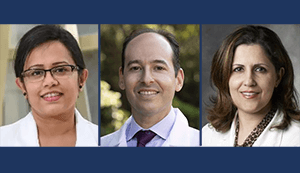HCRN sarcoma co-chairs united in vision and goals for new working group

2023 marked the establishment of a new Sarcoma Clinical Trial Working Group for HCRN. The group brings together some of the sharpest minds in cancer research who are focused on one of the rarest types of cancer.
The working group is led by (pictured from left) Atrayee Basu-Mallick, MD, interim director, Solid Tumor Division, and associate professor at Thomas Jefferson University; Mark Agulnik, MD, professor and section chief of sarcoma medical oncology in the Department of Medical Oncology & Therapeutics Research at City of Hope; and Kristen Ganjoo, MD, professor of medicine at Stanford University School of Medicine and the director of Stanford Sarcoma Program. The co-chairs are united in their goal of connecting sarcoma researchers who share a common purpose of finding more treatments for this challenging cancer.
Because sarcoma is a tumor of connective tissues (skin, nails, organs, fat, muscle, and anything that arises from the tissue) all over the body, it can develop and move anywhere in the body, said Dr. Basu-Mallick.
She also said that there are hundreds of histologies, “and each type has subtypes. So when you look at a specific tumor, you really need experts, because it is rare and heterogeneous – that’s the unique challenge and where you really need an expert team.”
Dr. Agulnik was attracted to working on sarcoma because of the ability to work with younger patients, helping them navigate the disease, and all of the aspects of care.
Caring for young people also drew Dr. Basu-Mallick’s interest. She also likes the challenge of diving into the complexity of sarcoma. “You’re never bored, and always kept humble,” she said.
All three co-chairs mentioned the connections they have with their patients is what inspires them.
Dr. Ganjoo said her desire to make great changes in cancer therapy was encouraged by Indiana University Melvin and Bren Simon Comprehensive Cancer Center researchers and HCRN co-founders Larry Einhorn, MD, and Patrick J. Loehrer, Sr., MD, particularly in their work to build a premier testicular cancer center. “And I thought that if I could do something like that, it would be an amazing change for patients.”
After a move from Indiana University to Stanford, Dr. Ganjoo said she “just fell in love with sarcoma, and that’s my life mission — to do something that will change patients’ lives.”
Because of the rarity of sarcoma, becoming an expert in the field can be a lonely undertaking. Dr. Agulnik said that he’s often a team of “one” at his institution, so he sees tremendous value in collaborating with colleagues across institutions through the new HCRN working group.
“The purpose of groups like this is really to get us all together to collaborate as if we were in the same space. Even though we don’t work in the same place, we have to create models that work for us as a group that other teams don’t necessarily have to create. To me, that has always been the challenge,” he explained.
“One thing is for certain; sarcoma oncologists love to collaborate and be part of groups because in our institutions we don’t have as many partners to collaborate with,” reiterated Dr. Basu-Mallick.
The co-chairs also cited the ability to mentor junior faculty and fellows as an asset the working group provides.
“We have a very unique opportunity that we could actually be training the next generation of physicians who will look after our patients,” said Dr. Agulnik.
Speed of innovation is another strength of the working group. “Smaller groups move things faster, because there aren’t as many layers and so many back-and-forths,” said Dr. Basu-Mallick.
As an example, Dr. Ganjoo noted the working group discussed, developed, and submitted a clinical trial proposal within about a three week period. “This was the fastest we’ve ever put an LOI through to a pharmaceutical funder. We did something in three weeks that usually takes six months.”
Dr. Agulnik also mentioned that a smaller group may allow more opportunities for career development and being able to change the field through drug discovery and getting into NCCN guidelines.
While the working group has already covered a lot of ground as a new collaboration in 2023, the co-chairs have strong goals for the year ahead, including the development of new sarcoma clinical trials with practice-changing potential.
With momentum building, Dr. Basu-Mallick concludes, “I think it is one of the most exciting cancers to treat in this day and age, because every day there is new discovery and technology that is improving. Although it’s a challenge, it is also a great opportunity.”
— Written by Lori Green LeRoy. Lori is an Indianapolis-based PR and communications professional and principal of Front Page Ink Communications.
About Hoosier Cancer Research Network:
Hoosier Cancer Research Network conducts innovative cancer clinical trials in collaboration with more than 100 academic and community clinical research sites across the United States. Our studies are designed by cancer researchers from our member institutions. The HCRN staff includes 55 team members who work together to support all aspects of the studies we manage, from the time we receive the initial concept from a researcher through the final publication of the study results. Currently, we are supporting more than 70 clinical trials across a wide range of cancer types. Over our 40-year history, more than 10,000 participants in have enrolled in our clinical trials, leading to important discoveries that help cancer patients live longer and better after their cancer diagnosis.

Facebook
Hoosier Cancer Research Network on Facebook
Linked In
You Tube
Twitter